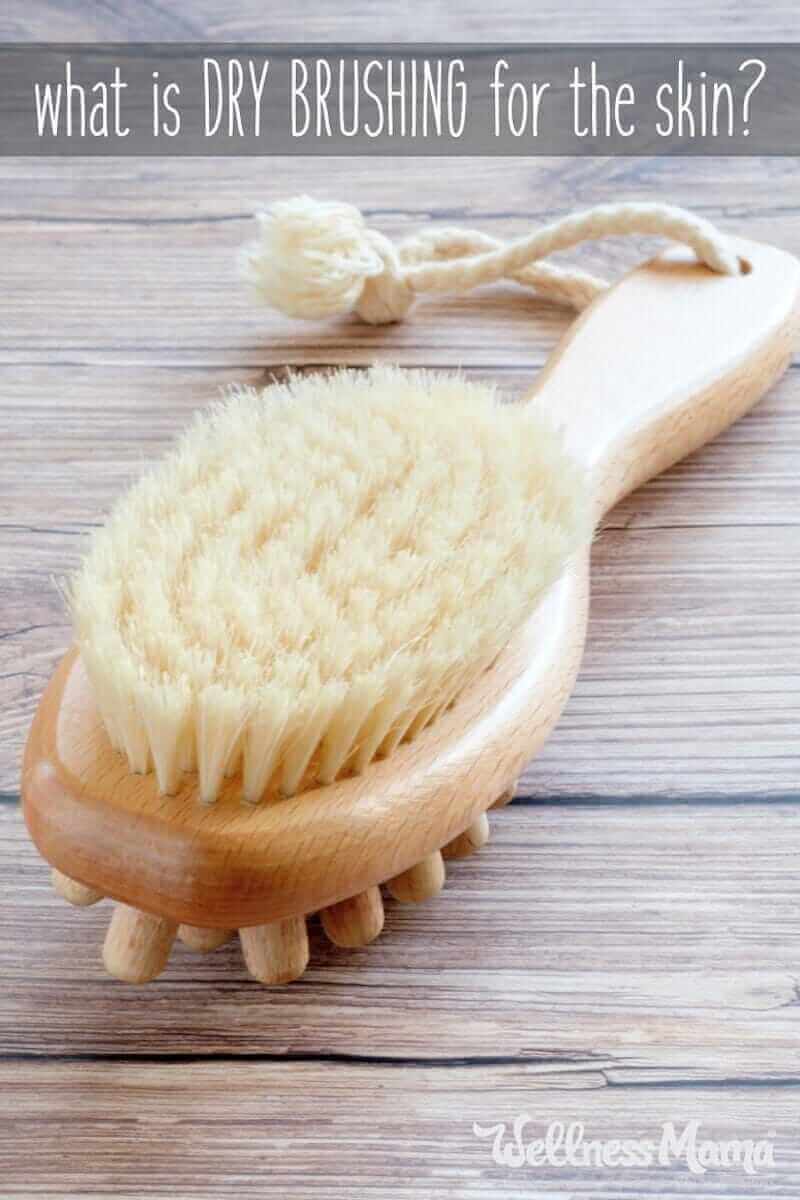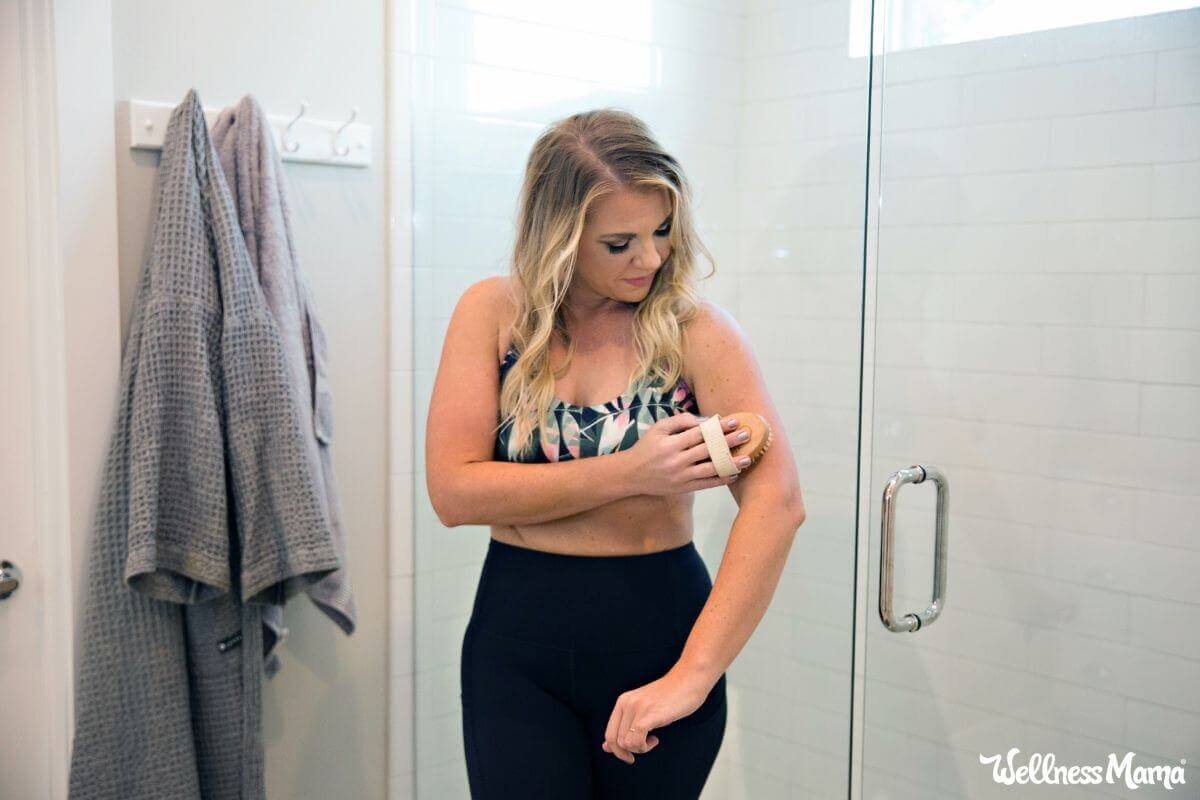You probably brush your hair, and your teeth (hopefully with natural toothpaste), but do you brush your skin? And why would you?
This practice has been gaining popularity lately and with good reason. I’ve even noticed “dry brushing” as an offering on the menu at spas in hotels. Dry brushing has many potential benefits, from smoother skin to helping with lymphatic drainage.
So what is it and why should you consider doing it?
Benefits of Dry Brushing for Skin
Dry brushing is exactly what it sounds like… brushing the skin in a particular pattern with a dry brush, usually before showering.
In dry brushing, the skin is typically brushed toward the heart, starting at the feet and hands and brushing toward the chest.
I’ve been dry brushing my skin for years, mostly because it feels great and makes my skin softer, but there are other benefits as well:
1. Lymphatic Support
The lymphatic system is a major part of the body’s immune system. It is made up of organs and lymph nodes, ducts, and vessels that transport lymph throughout the body. Many of these lymph vessels run just below the skin. Proponents of dry brushing claim that brushing the skin regularly helps stimulate the normal lymph flow within the body and helps the body detoxify itself naturally.
2. Exfoliation
This benefit is often noticed the first time a person dry brushes. The process of running a firm, natural bristled brush over the skin helps loosen and remove dead skin cells, naturally exfoliating skin. I noticed less dry skin and much softer skin in the first few days and weeks after dry skin brushing. My skin has stayed soft thanks to this built-in way to exfoliate.
3. Clean Pores (& Smaller Pores!)
The added benefit of exfoliating the skin is clearing oil, dirt, and residue from the pores. Use a smaller, gentler dry brush for the face (don’t use the stiffer body brush here… ouch!). I notice that my face is softer and my pores are much less noticeable.
4. Reduces Cellulite
Though the evidence is anecdotal, I’ve found many accounts of people who claimed that regular dry brushing greatly helps to reduce cellulite. I talked about this and my other cellulite remedies here. There isn’t much research to back the cellulite claims, but dry brushing feels great and makes skin softer, so there isn’t really any downside to trying it!
5. Natural Energy Boost
I can’t explain why but dry brushing always gives me a natural energy boost. For this reason, I wouldn’t recommend dry brushing at night but it is great in the morning. One theory is that because it increases circulation, it also increases energy. Either way, I only do it early in the day as part of my morning routine.
Selecting a Dry Brush
I use a firm, natural bristle brush with a long handle, which allows me to reach my entire back and easily brush the bottoms of my feet and the backs of my legs. This set of brushes is my favorite because it includes a face brush and two body brushes with different firmness.
When I started dry brushing, my skin was much more sensitive and I preferred the softer one, and now I much prefer the firmer brush. With the set, I have options. I recommend replacing the brush every 6-12 months as the bristles will eventually wear out. I also wash my brush every few weeks to remove dead skin cells.
How to Dry Brush
Materials
- body brushes a gentle brush is best
- natural lotion optional
Instructions
- Starting at the feet, brush the bottoms of the feet and up the legs in long, smooth strokes. Brush each section of skin about 10 times. It's important to brush up toward the heart/chest area where the lymph system drains.
- Repeat the same process with the arms, starting with the palms of the hands and brushing up the arm toward the heart. Again, brush each section of skin about 10 times.
- On the stomach and armpits, brush in a circular clockwise motion.
- Repeat the process on the abdomen and back.
- Use a more delicate brush on your face to finish off the dry brushing process.
- Follow up with lotion if desired.
Notes
But, Does Skin Brushing Actually Work?
I have personally dry brushed for years and noticed that my skin is softer (and possibly firmer, though this is hard to measure) from dry brushing. Skin brushing is very invigorating, easy, and a low investment of time and money, so I keep up the habit.
Especially during pregnancy, I *personally* found that dry brushing seemed to help keep me from getting stretch marks and also seemed to help tighten skin after pregnancy.
Here’s the thing:
It isn’t meant to be a medical treatment and shouldn’t be considered one. Dermatologists also claim that cellulite is genetic and that there is no cure, while podcast guest Dr. Cate Shanahan would disagree and points the finger at polyunsaturated omega-6 fats in our diet.
What the Scientific Evidence Says
The evidence is divided and several sources point out the obvious fact — there have not been any specific scientific studies about dry brushing. Much of the evidence, especially relating to the cellulite benefit, is anecdotal. Much more research would be needed before dermatologists would consider it a legitimate medical treatment.
Supporters of dry brushing claim that it can stimulate the lymph system, help the body rid itself of toxins, and increase circulation or energy. Even dermatologists agree that gently brushing the skin does have exfoliating benefits and may go beyond skincare by stimulating the body in a way similar to massage, which certainly does have well-documented benefits.
I’m not completely sold on all of those benefits, but this definitely falls in the “can’t hurt” category, with one exception…
A Warning for Sensitive Skin
Always, my advice is to pay attention to what works for you and your body. If you have sensitive skin or a history of eczema or other skin conditions, this is one health habit you may want to skip. As Sarah from the Healthy Home Economist found, aggressive skin brushing could irritate sensitive skin over time.
Still, as long as you don’t ignore warning signs like discomfort, itchiness, redness, or even pain, done the right way a dry brushing session should benefit most people. Avoid sensitive areas, don’t use overly firm bristles, and stop if bothersome symptoms occur.
As a gentler detox option for sensitive skin, try a detox bath instead of skin brushing.
The Bottom Line on Skin Brushing: Find What Works for You
At the end of the day, researchers will likely never do studies on dry brushing so we don’t have solid scientific evidence of its benefits. There is no incentive to do such a study when a good quality brush set costs around $20 and is available online. At the same time, it is generally agreed that the practice is harmless and at worst ineffective.
Like any aspect of health (or life), it is important to do your own research and go with what works for you.
This article was medically reviewed by Madiha Saeed, MD, a board certified family physician. As always, this is not personal medical advice and we recommend that you talk with your doctor.
Have you ever dry brushed? Will you try it?




Leave a Reply